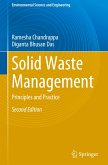E-Waste: From Generation to Management-Practices, Challenges, and Solutions
Herausgegeben:Shukla, Prashant; Choudhary, Sachi; Ranjit, P. S.; Verma, Akarsh
E-Waste: From Generation to Management-Practices, Challenges, and Solutions
Herausgegeben:Shukla, Prashant; Choudhary, Sachi; Ranjit, P. S.; Verma, Akarsh
- Gebundenes Buch
- Merkliste
- Auf die Merkliste
- Bewerten Bewerten
- Teilen
- Produkt teilen
- Produkterinnerung
- Produkterinnerung
This book aims to create a comprehensive guide that explores the lifecycle of electronic waste, from its creation to its disposal. The main themes and objectives of this book revolve around understanding the various dimensions of e-waste management, including its environmental, social, economic, and regulatory aspects. Through a series of meticulously curated chapters, the book navigates through the lifecycle of electronic products, from production to disposal, and examines the environmental and health impacts associated with improper e-waste handling. It delves into the legal and regulatory…mehr
Andere Kunden interessierten sich auch für
![Solid Waste Management Solid Waste Management]() Ramesha ChandrappaSolid Waste Management190,99 €
Ramesha ChandrappaSolid Waste Management190,99 €![Solutions For Sustainability Challenges Solutions For Sustainability Challenges]() Wulf-Peter SchmidtSolutions For Sustainability Challenges98,99 €
Wulf-Peter SchmidtSolutions For Sustainability Challenges98,99 €![Global Net Zero Carbon Practices in Construction Global Net Zero Carbon Practices in Construction]() Global Net Zero Carbon Practices in Construction113,99 €
Global Net Zero Carbon Practices in Construction113,99 €![Proceedings of 6th International Conference on Resources and Environmental Research - ICRER 2024 Proceedings of 6th International Conference on Resources and Environmental Research - ICRER 2024]() Proceedings of 6th International Conference on Resources and Environmental Research - ICRER 2024151,99 €
Proceedings of 6th International Conference on Resources and Environmental Research - ICRER 2024151,99 €![Proceedings of 5th International Conference on Resources and Environmental Research-ICRER 2023 Proceedings of 5th International Conference on Resources and Environmental Research-ICRER 2023]() Proceedings of 5th International Conference on Resources and Environmental Research-ICRER 2023151,99 €
Proceedings of 5th International Conference on Resources and Environmental Research-ICRER 2023151,99 €![Challenges for Sustainable Solid Waste Management Challenges for Sustainable Solid Waste Management]() Chanathip PharinoChallenges for Sustainable Solid Waste Management38,99 €
Chanathip PharinoChallenges for Sustainable Solid Waste Management38,99 €![Proceedings of the 9th International Conference on Physical and Mathematical Modelling of Earth and Environmental Processes Proceedings of the 9th International Conference on Physical and Mathematical Modelling of Earth and Environmental Processes]() Proceedings of the 9th International Conference on Physical and Mathematical Modelling of Earth and Environmental Processes176,99 €
Proceedings of the 9th International Conference on Physical and Mathematical Modelling of Earth and Environmental Processes176,99 €-
-
-
This book aims to create a comprehensive guide that explores the lifecycle of electronic waste, from its creation to its disposal. The main themes and objectives of this book revolve around understanding the various dimensions of e-waste management, including its environmental, social, economic, and regulatory aspects. Through a series of meticulously curated chapters, the book navigates through the lifecycle of electronic products, from production to disposal, and examines the environmental and health impacts associated with improper e-waste handling. It delves into the legal and regulatory frameworks governing e-waste management, explores sustainable design principles and circular economy approaches, and showcases best practices and case studies from around the globe. A key distinguishing feature of this work lies in its comprehensive coverage of e-waste management, encompassing diverse perspectives and experiences from both developed and developing regions. By presenting arich tapestry of methodologies, case studies, and practical insights, the manuscript offers a nuanced understanding of the challenges and opportunities in e-waste management, tailored to the needs of researchers, practitioners, policymakers, and stakeholders alike. Furthermore, it adopts an interdisciplinary approach, drawing upon insights from environmental science, engineering, policy studies, economics, and sociology to provide a holistic understanding of e-waste management. It embraces innovation and sustainability as guiding principles, encouraging readers to explore novel solutions and collaborative approaches in tackling the global e-waste crisis.
Produktdetails
- Produktdetails
- Verlag: Springer / Springer Nature Singapore / Springer, Berlin
- Artikelnr. des Verlages: 978-981-95-0328-5
- Seitenzahl: 364
- Erscheinungstermin: 28. Oktober 2025
- Englisch
- Abmessung: 241mm x 160mm x 26mm
- Gewicht: 709g
- ISBN-13: 9789819503285
- ISBN-10: 9819503280
- Artikelnr.: 74974202
- Herstellerkennzeichnung
- Springer-Verlag KG
- Sachsenplatz 4-6
- 1201 Wien, AT
- ProductSafety@springernature.com
- Verlag: Springer / Springer Nature Singapore / Springer, Berlin
- Artikelnr. des Verlages: 978-981-95-0328-5
- Seitenzahl: 364
- Erscheinungstermin: 28. Oktober 2025
- Englisch
- Abmessung: 241mm x 160mm x 26mm
- Gewicht: 709g
- ISBN-13: 9789819503285
- ISBN-10: 9819503280
- Artikelnr.: 74974202
- Herstellerkennzeichnung
- Springer-Verlag KG
- Sachsenplatz 4-6
- 1201 Wien, AT
- ProductSafety@springernature.com
Dr. Prashant Shukla is an Associate Professor at the School of Advanced Engineering, UPES Dehradun, and a certified CAEV trainer by MG Motors. He holds a Ph.D. in Mechanical Engineering with a specialization in waste management technologies, automotive systems, and machine design. With over a decade of academic experience, he has made significant contributions to teaching, curriculum development, and research, particularly in the areas of sustainable mobility, energy harvesting, and innovative waste segregation systems. Dr. Shukla has also served as an Online Instructor of Design Thinking at the New School of Architecture & Design, San Diego, where he introduced students to creative and human-centered problem-solving approaches. His research has led to the granting of nine patents and several design registrations, reflecting his commitment to practical, real-world innovations. He has published extensively in reputed journals and contributed to multiple book chapters and academic books on DFMA, electric vehicles, and waste-to-wealth technologies. His work is supported by projects funded by academic and industrial bodies, including MG Motors, Hero MotoCorp, KPIT Sparkle, and UREDA. Dr. Sachi, an Assistant Professor (SG) at UPES Dehradun, holds a Ph.D. in Computer Science and Engineering and boasts 11 years of rich experience in academia, research, and innovation. With a remarkable track record of intellectual property rights (IPRs) and noteworthy publications, Dr. Sachi is recognized for her expertise in computer science. Despite her background, she has embarked on an exciting journey into waste management, particularly focusing on electronic waste (e-waste) and sustainable practices. Dr. P.S. Ranjit is a distinguished academician, researcher, and industry collaborator with over 22 years of teaching experience across undergraduate and postgraduate engineering programs. He currently serves as the Dean – International Relations and Professor in the Department of Mechanical Engineering at Aditya University, Surampalem, Andhra Pradesh, a role he has held since 2018. Prior to this, he led the Automotive Design Engineering division at UPES, Dehradun, for a decade, where he was instrumental in shaping industry-driven academic programs and research initiatives. He holds a Ph.D. in Internal Combustion Engines, an M.E. in Mechanical Engineering, and a B.E. in Automobile Engineering, in which he secured a University Second Rank, along with a State Rank in his Diploma in Automobile Engineering. His academic and professional affiliations are notable—he is a Board of Studies Member at JNTU Kakinada, SAEINDIA Faculty Development Core Committee Member, and Managing Committee Member of SAEINDIA Amaravathi Division. Prof. (Dr.) Akarsh Verma is currently working as an Assistant Professor at the UPES (University of Petroleum and Energy Studies), Dehradun, India. He obtained a Ph.D. in Mechanical Engineering from the Indian Institute of Technology (IIT) Roorkee, India; and did his postdoctoral research work at Brigham Young University, USA. He serves the research community by acting as a reviewer for various International journals (Nature, Elsevier, Springer, Sage, Taylor & Francis, Wiley, IOP, etc.) and has reviewed several research articles. In addition, he has published various research articles in high-quality international peer-reviewed journals, many books and book chapters, and has also presented many research papers at various international/national conferences.
Chapter 1:Introduction to E-Waste: Definitions, Scope, and SignificanceThis chapter provides an introduction to electrical and electronic waste (E-waste), defining what it is, its scope, and its significance in today's world. It explores the various types of E-waste and their sources, setting the stage for understanding the challenges and opportunities in e-waste management.- Chapter 2:Global Trends in E-Waste Generation and ManagementThis chapter examines the trends in e-waste generation and management on a global scale. It analyzes data on the quantities and types of e-waste generated worldwide, as well as the methods and practices used for its management and disposal. The chapter highlights key patterns and shifts in e-waste management over time.- Chapter3:Environmental and Health Impacts of E-Waste Focusing on the environmental and health impacts of e-waste, this chapter explores the consequences of improper disposal and recycling of electrical components and electronic devices. It discusses the pollutants released from e-waste and their effects on ecosystems, human health, and the broader environment.- Chapter 4:Legal and Regulatory Frameworks for E-Waste Management This chapter examines the legal and regulatory frameworks governing e-waste management at national and international levels. It discusses the laws, regulations, and policies aimed at addressing e-waste issues, as well as the challenges and opportunities associated with their implementation and enforcement.- Chapter 5:E-Waste Collection, Sorting, and Handling Practices Exploring the practical aspects of e-waste management, this chapter focuses on collection, sorting, and handling practices. It discusses the methods and technologies used for collecting and processing e-waste, including segregation, dismantling, and transportation, highlighting best practices and challenges in these areas.- Chapter 6:Sustainable Design and Product Lifecycle Management This chapter examines the role of sustainable design and product lifecycle management in reducing e-waste generation. It discusses strategies for designing electronics with longevity, reparability, and recyclability in mind, as well as approaches for extending product lifecycles through repair, refurbishment, and remanufacturing.- Chapter 7:Social and Economic Aspects of E-Waste Management Focusing on the social and economic dimensions of e-waste management, this chapter explores the impacts on communities, livelihoods, and economies. It discusses the role of informal e-waste sectors, the socio-economic implications of e-waste recycling, and the importance of inclusive and equitable approaches to management.- Chapter 8:Circular Economy Approaches to E-Waste Management This chapter examines circular economy approaches to e-waste management, emphasizing strategies for resource recovery, reuse, and recycling. It discusses circular business models, such as product-as-a-service and take-back schemes, as well as the potential for creating closed-loop systems in the electronics industry.- Chapter 9:Case Studies in Successful E-Waste Management Practices Sub topics :a. E-Waste Management Initiatives in Developing Countries b. Best Practices in E-Waste Recycling Facilities c. Community-Based E-Waste Management Programs This chapter is featuring case studies from around the world, this chapter highlights successful e-waste management initiatives and practices. It showcases examples of innovative programs, projects, and partnerships that have effectively addressed e-waste challenges, providing insights and lessons learned for practitioners and policymakers.- Chapter 10:Case Studies for Management of Major Components in E-Waste (e.g., Household appliances, EV batteries and PV panels, Electronic gadgets and IT industry components etc.)8This chapter will delve into case studies focusing on a range of major e-waste components, including household appliances, EV batteries and PV panels, electronic gadgets, and components from the IT industry. Through detailed analysis and exploration of these case studies, readers will gain insights into innovative approaches and successful initiatives in e-waste management.- Chapter 11:Impact of E-Waste on Important Geographical Regions Sub Topics: a. E-Waste Management Challenges in Asia b. E-Waste Recycling Innovations in Europe c. E-Waste Policies and Practices in North America This chapter is focusing on specific geographical regions, this chapter examines the impact of e-waste on ecosystems, communities, and economies. It explores the unique challenges and opportunities faced by different regions in managing e-waste, providing insights into regional variations in policies, practices, and outcomes.- Chapter 12:Emerging Technologies for E-Waste Recycling and Resource Recovery This chapter explores emerging technologies for e-waste recycling and resource recovery, highlighting innovative approaches for recovering valuable materials from electronic devices. It discusses advancements in recycling processes, including mechanical, chemical, and biotechnological methods, as well as their potential environmental and economic benefits.- Chapter 13:Future Trends and Directions in E-Waste Management Research and Practice Focusing on future trends and directions, this chapter explores emerging issues, challenges, and opportunities in e-waste management. It discusses areas for future research, technological innovation, policy development, and international collaboration, offering insights into the evolving landscape of e-waste management.
Chapter 1:Introduction to E-Waste: Definitions, Scope, and SignificanceThis chapter provides an introduction to electrical and electronic waste (E-waste), defining what it is, its scope, and its significance in today's world. It explores the various types of E-waste and their sources, setting the stage for understanding the challenges and opportunities in e-waste management.- Chapter 2:Global Trends in E-Waste Generation and ManagementThis chapter examines the trends in e-waste generation and management on a global scale. It analyzes data on the quantities and types of e-waste generated worldwide, as well as the methods and practices used for its management and disposal. The chapter highlights key patterns and shifts in e-waste management over time.- Chapter3:Environmental and Health Impacts of E-Waste Focusing on the environmental and health impacts of e-waste, this chapter explores the consequences of improper disposal and recycling of electrical components and electronic devices. It discusses the pollutants released from e-waste and their effects on ecosystems, human health, and the broader environment.- Chapter 4:Legal and Regulatory Frameworks for E-Waste Management This chapter examines the legal and regulatory frameworks governing e-waste management at national and international levels. It discusses the laws, regulations, and policies aimed at addressing e-waste issues, as well as the challenges and opportunities associated with their implementation and enforcement.- Chapter 5:E-Waste Collection, Sorting, and Handling Practices Exploring the practical aspects of e-waste management, this chapter focuses on collection, sorting, and handling practices. It discusses the methods and technologies used for collecting and processing e-waste, including segregation, dismantling, and transportation, highlighting best practices and challenges in these areas.- Chapter 6:Sustainable Design and Product Lifecycle Management This chapter examines the role of sustainable design and product lifecycle management in reducing e-waste generation. It discusses strategies for designing electronics with longevity, reparability, and recyclability in mind, as well as approaches for extending product lifecycles through repair, refurbishment, and remanufacturing.- Chapter 7:Social and Economic Aspects of E-Waste Management Focusing on the social and economic dimensions of e-waste management, this chapter explores the impacts on communities, livelihoods, and economies. It discusses the role of informal e-waste sectors, the socio-economic implications of e-waste recycling, and the importance of inclusive and equitable approaches to management.- Chapter 8:Circular Economy Approaches to E-Waste Management This chapter examines circular economy approaches to e-waste management, emphasizing strategies for resource recovery, reuse, and recycling. It discusses circular business models, such as product-as-a-service and take-back schemes, as well as the potential for creating closed-loop systems in the electronics industry.- Chapter 9:Case Studies in Successful E-Waste Management Practices Sub topics :a. E-Waste Management Initiatives in Developing Countries b. Best Practices in E-Waste Recycling Facilities c. Community-Based E-Waste Management Programs This chapter is featuring case studies from around the world, this chapter highlights successful e-waste management initiatives and practices. It showcases examples of innovative programs, projects, and partnerships that have effectively addressed e-waste challenges, providing insights and lessons learned for practitioners and policymakers.- Chapter 10:Case Studies for Management of Major Components in E-Waste (e.g., Household appliances, EV batteries and PV panels, Electronic gadgets and IT industry components etc.)8This chapter will delve into case studies focusing on a range of major e-waste components, including household appliances, EV batteries and PV panels, electronic gadgets, and components from the IT industry. Through detailed analysis and exploration of these case studies, readers will gain insights into innovative approaches and successful initiatives in e-waste management.- Chapter 11:Impact of E-Waste on Important Geographical Regions Sub Topics: a. E-Waste Management Challenges in Asia b. E-Waste Recycling Innovations in Europe c. E-Waste Policies and Practices in North America This chapter is focusing on specific geographical regions, this chapter examines the impact of e-waste on ecosystems, communities, and economies. It explores the unique challenges and opportunities faced by different regions in managing e-waste, providing insights into regional variations in policies, practices, and outcomes.- Chapter 12:Emerging Technologies for E-Waste Recycling and Resource Recovery This chapter explores emerging technologies for e-waste recycling and resource recovery, highlighting innovative approaches for recovering valuable materials from electronic devices. It discusses advancements in recycling processes, including mechanical, chemical, and biotechnological methods, as well as their potential environmental and economic benefits.- Chapter 13:Future Trends and Directions in E-Waste Management Research and Practice Focusing on future trends and directions, this chapter explores emerging issues, challenges, and opportunities in e-waste management. It discusses areas for future research, technological innovation, policy development, and international collaboration, offering insights into the evolving landscape of e-waste management.








